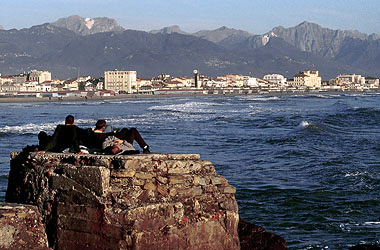
Closed between the Trrenian Sea and the Apuan Alps, in the northernmost corner of Toscana, Versilia is a synthesis of culture and nature. A 20 km long straight strip of coast surrounding hills with olive groves and vineyards, the area around Massaciuccoli Lake, the peaks of the Apuans, the presence of archaeological sites, Romanesque churches, Medieval villages, fortresses and castles: all this is proof of the long history of a region inhabited since Neolithic times. Writers, artists, actors, as well as a large number of amateurs with an interest in culture all meet here in summer, while a number of literary and film festivals attract experts and onlookers alike in winter.
A truly exceptional region this, with its fortresses, villages and towers along the coast, documents of a past that forged important towns: Forte dei Marmi, Pietrasanta and Viareggio on the coast, Massarosa near Massaciuccoli Lake, Camaiore on the hills, Stazzema and Seravezza in Upper Versilia and, finally, the communes around which are gathered a number of smaller villages of extraordinary natural beauty and with a rich and eventful history.
Details:
Versilia has a very long history, ranging from the prehistoric period with native Ligurian peoples who eventually succumbed to the Roman newcomers, through barbarian invasions and Middle Ages that saw the so called "cattani" or "capitanei" as feudal lords, right up to the political ambitions of the Florentine Medici dynasty first and the Lorena after. The events that involved the coast, the hills and the mountains are connected to a series of factors: in the first place the healthy climate of the places chosen by the inhabitants and the possibility to defend them and, secondly, the presence of roads and the economic and commercial interests capable of shaping the region. The Romans carried out an important land reform with the "centuriation" of the whole territory between Arno and Magra. They also built two major roads, the "Via Aurelia" and the "Via Aemilia Scauri", an extension of the former to the north from Pisa. The region changed once again aspect with the arrival of barbarian peoples like the Lombards who built the first forts on the hills. The Lombards opened a new, extremely important road, the "Via Francigena" or "Romea". In the Middle Ages the typical political fragmentation led also in Versilia to the formation of small communities under the control of vassalli: the so called "cattani versilienses". Though many of their forts were destroyed in the territorial struggle between the end of the XIIth and the beginning of the XIIIth century, precious evidence is still preserved and can be seen today. The government of Lucca eventually defeated the feudal lords and gained an outlet to the sea. Important works that helped Versilia to develop were carried out under the Lorena who planted trees and drained the area along the coast, as well as stimulating the activity of the quarries. The latter became the motor of Versilia's economic development during the XIXth century. In the middle of that century, indeed, Versilia became part of the Grand Duchy of Toscana and some years later of the Kingdom of Italy.
On account of its morphological diversity the Versilia region has given rise to fortifications that are very different in function and type. Together with towers along the coast, we also find rocche and castles. The first group includes Torre Matilde in Viareggio, the fort of Motrone and that of Forte dei Marmi, as well as the important "rocca di Sala" and the "rocchetta fiorentina", both in Pietrasanta and the XVIth century tower of Salto della Cervia, that we consider as a "tower on the coast" although it is more than 3 km away from it. In the hills we find many castles around the communes of Camaiore and Massarosa. The Medieval towers along the coast were essentially watchtowers whose task was to signal to the other towers the presence of pirates, whereas the XVIIIth century forts that took their place served also as customs and for sanitary purposes. A typical example is the XVIIIth century fort of Forte dei Marmi.
On the hills, the castles are more complex constructions that served both for defence and as dwellings. Observing a map of their distribution we see that they are never built higher than 400 m a.s.l. This was, indeed, the limit for growing olives and vines, essential for the survival of the population, while higher up the woods provided wood and the mountains clear springs. They were small self-sufficient communities that gathered within the castle walls to escape enemy attacks. Typical examples are the fortified villages scattered in the Camaiore area.
Among the elements that contributed to the development of the Versilia region one of the most important was the presence of roads along the coast and on the hills, connecting the towers with each other and the Versilia with that of Lucca further inland. The Romans reached this part of Toscana in the IIIrd century b.C., fighting against the native nomads to gain control of the coast and from there start towards the conquest of Spain and Gallia. When the Romans conquered Versilia, in particular the area between the rivers Arno and Magra, it became a frontier region between the colony of Pisa, allied with Rome and that of Luni. So the roads became essential for trade and for the passage of armies and mercenary troops descending from northern Europe: in order to defend them fortifications were built along the coast and on the heights. Besides the "Aemilia Scauri", built in the Ist century b.C., departing from the Aurelia at Pisa and continuing inland to Versilia, another important road was traced from the VIIth century, the so called Francigena or "Romea" linking Camaiore with Lucca along its way from northern Europe to Rome. In the course of centuries, right up to the Renaissance, Lucca, Pisa, Genova and also Firenze fought for the control of this portion of coast. The mountainous part of Versilia, the so called "colonia lucensis", belonged to Lucca while the coast or "ager pisanus" belonged to Pisa. Another road, this time modern, permitted a rather modest marble warehouse along the Versilian coast to develop into an important town, Forte dei Marmi. The town began to grow thanks to the development of marble quarrying activities, promoted by the ruling Medici dynasty, from the XVIth century onwards. It was decided that the port of Motrone was too far away and so a road was built connecting Querceta with the coast and permitting a more efficient transport of the marble.





